Video Library
SIGN UP TO STAY INFORMEDIn this section click to expand contents
SAMSCA® (tolvaptan) and Hyponatremia Video Library
SAMSCA: Mechanism of Action See how SAMSCA works to promote free water clearance by direct antagonism of the renal
SAMSCA® (tolvaptan) MOA This video gives an in-depth, illustrated explanation of how SAMSCA works to promote free water clearance by direct antagonism of the renal V2-receptors.


